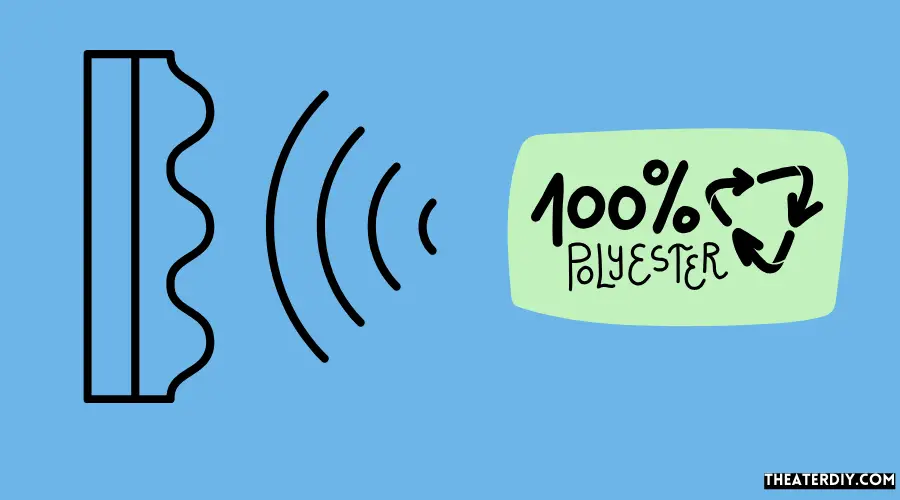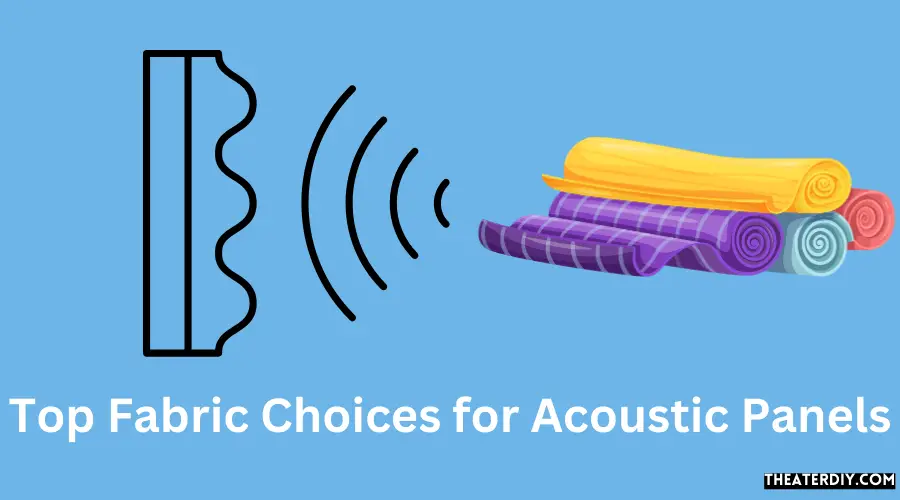The best fabrics for acoustic panels include breathable cotton duck, muslin, polyester, burlap, and sound away guilford of maine jane 9085 acoustic fabric and couture 4858 acoustic fabric. These fabrics are ideal for diy acoustic panels as they provide good sound absorption and are available in various colors.
1. Breathable Fabrics For Improved Acoustic Performance
Breathable fabrics, such as cotton duck, muslin, and polyester, are considered the best options for improving the acoustic performance of panels. These fabrics allow sound waves to pass through more easily, resulting in enhanced sound absorption and clarity.
What Are Breathable Fabrics?
Breathable fabrics are materials that allow the passage of air and moisture through them. These fabrics have open weaves or pores that enable better airflow compared to non-breathable fabrics. When used in the construction of acoustic panels, breathable fabrics help to improve the overall acoustic performance by allowing sound waves to pass through more easily.
The Role Of Breathability In Acoustic Panels
Breathability plays a crucial role in the effectiveness of acoustic panels. When sound waves hit the panels, the breathable fabric allows the sound to pass through the panel material and into the sound-absorbing material inside. The ability of the fabric to allow air and sound to flow through helps in capturing and absorbing the sound energy, resulting in improved acoustic performance.
Benefits of using breathable fabrics for acoustic panels:
- Improved sound absorption: Breathable fabrics enhance the sound absorption capabilities of acoustic panels by allowing sound waves to pass through more freely. This results in a more efficient reduction of echo and reverberation in a room.
- Better airflow: The breathability of the fabric promotes better air circulation within the panel structure, preventing the buildup of moisture and minimizing the risk of mold or mildew growth. This is especially beneficial in environments with high humidity levels.
- Enhanced durability: Breathable fabrics tend to be more resistant to wear and tear, as they can better withstand the regular airflow and movement of sound waves passing through them. This makes them suitable for long-term use in acoustic panel installations.
- Aesthetically pleasing: Breathable fabrics come in a wide range of colors, patterns, and textures, allowing for greater customization and integration into the overall design of a space. This ensures that acoustic panels not only perform well acoustically but also enhance the visual appeal of the room.
- Eco-friendly options: Many breathable fabrics used for acoustic panels are made from sustainable materials, such as organic cotton or recycled polyester. Choosing these eco-friendly options helps reduce the environmental impact of your acoustic panel installation.
Using breathable fabrics for acoustic panels offers several advantages, including improved sound absorption, better airflow, enhanced durability, aesthetic appeal, and eco-friendliness. These fabrics allow for the efficient transfer of sound waves and air, resulting in optimal acoustic performance and a pleasant auditory environment.
2. Cotton Duck: A Versatile Option For Acoustic Panels
Cotton duck is a versatile fabric option for acoustic panels, providing excellent sound absorption and breathability. Its unique properties make it an ideal choice for creating effective and functional soundproofing solutions.
Understanding Cotton Duck Fabric
Cotton duck fabric is a versatile option for acoustic panels that offers several benefits. It is a heavyweight, woven fabric that is made from 100% cotton fibers. The term “duck” refers to the tight weave of the fabric, which makes it durable and resistant to tearing or fraying.
Cotton duck fabric is commonly used in various applications, including clothing, bags, and home furnishings. Its natural properties and composition make it a top choice for acoustic panels.
Why Cotton Duck Is A Top Choice For Acoustic Panels
Cotton duck fabric is highly regarded for its suitability in creating effective acoustic panels. Here’s why it stands out as a top choice:
- Sound absorption: Cotton duck fabric has excellent sound-absorbing properties, which is crucial for acoustic panels. The dense weave of the fabric helps to reduce echo and reverberation, creating a more balanced and pleasant sound environment.
- Durability: The heavyweight nature of cotton duck fabric ensures that the acoustic panels will withstand the test of time. This fabric is known for its sturdiness and resilience, making it an ideal choice for long-lasting acoustic panels.
- Easy to work with: Cotton duck fabric is relatively easy to handle and work with, making it suitable for diy projects. It can be easily cut, sewn, and stretched onto frames or panels, allowing for effortless customization of acoustic panels.
- Versatility: Cotton duck fabric comes in various colors and finishes, providing designers and diy enthusiasts with a wide range of choices. Whether you prefer a neutral tone or a vibrant hue, there is a cotton duck fabric option to suit your aesthetic preferences.
With its excellent sound absorption capabilities, durability, ease of use, and versatility, cotton duck fabric emerges as a top choice for acoustic panels. Its performance and visual appeal make it a go-to option for creating effective and aesthetically pleasing acoustic solutions.
3. Muslin: A Lightweight And Effective Acoustic Panel Fabric
Muslin is a lightweight and effective fabric for acoustic panels, making it one of the best choices for sound absorption. Its breathable nature allows sound waves to pass through while reducing echo and reverberation in a room.
Exploring The Characteristics Of Muslin Fabric:
- Muslin is a lightweight and versatile fabric commonly used in the textile industry.
- It is made from cotton and has a plain woven construction, giving it a smooth and fine texture.
- Muslin is known for its breathability, allowing air to pass through easily.
- This fabric is typically unbleached and can come in various natural shades, including off-white and cream.
- Muslin is easy to work with, making it a popular choice for diy projects such as acoustic panels.
How Muslin Enhances Sound Quality In Acoustic Panels:
- Muslin fabric has excellent sound absorption properties, making it ideal for acoustic panels.
- Its open-weave structure allows sound waves to pass through the fabric, reducing echo and reverberation in a room.
- Muslin effectively traps and absorbs sound, resulting in improved acoustics and clearer sound quality.
- By using muslin fabric as the outer layer of acoustic panels, unwanted noise and vibrations can be significantly reduced.
Advantages Of Using Muslin For Acoustic Panels:
- Lightweight: Muslin is a lightweight fabric, which makes it easy to handle and install on acoustic panels.
- Breathable: The breathable nature of muslin allows sound waves to pass through, enhancing the sound absorption capabilities of the panels.
- Cost-effective: Muslin is an affordable fabric option for acoustic panels, making it accessible for those on a budget.
- Versatile: Muslin can be easily dyed, painted, or printed on, allowing for customization and creative designs on acoustic panels.
- Durable: Despite its lightweight nature, muslin is durable and can withstand regular use without losing its effectiveness.
Using muslin fabric for acoustic panels is a practical and effective choice. Its unique characteristics, such as being lightweight, breathable, and cost-effective, contribute to improved sound quality and enhanced acoustics in any space. With its versatility and durability, muslin is an excellent fabric option for diy acoustic panel projects.
4. Polyester: Durable And Acoustically Effective

Polyester fabric is a durable and acoustically effective choice for acoustic panels. With its durability and sound absorption capabilities, polyester is one of the best fabrics for creating effective soundproofing solutions.
An Overview Of Polyester Fabric:
Polyester fabric is a popular choice for acoustic panels due to its durability and acoustic effectiveness. Its unique properties make it a suitable material for creating effective sound absorption panels. Polyester fabric is made from synthetic fibers derived from petroleum, offering a range of benefits for acoustic applications.
Why Polyester Is A Suitable Fabric For Acoustic Panels:
- Broad frequency range absorption: Polyester fabric has excellent sound absorption capabilities across a wide range of frequencies. It effectively absorbs mid and high-frequency sounds commonly found in rooms, reducing reverberation and echoes.
- Resistant to moisture and humidity: Polyester is a hydrophobic material, meaning it repels moisture. This makes it a suitable choice for acoustic panels used in environments with high humidity levels, such as bathrooms and kitchens. Polyester fabric will not absorb moisture, ensuring its longevity and maintaining its acoustic performance.
- Durable and long-lasting: Polyester fabric is known for its durability. It is able to withstand wear and tear, making it ideal for applications where the panels may be subjected to frequent handling or other physical stressors. Additionally, polyester fabric is resistant to fading, ensuring that the acoustic panels maintain their appearance and effectiveness over time.
- Easy to clean: Polyester fabric is easy to clean and maintain. It can be spot cleaned or gently wiped down with a damp cloth, making it an ideal choice for high-traffic areas or environments prone to dirt and stains. This ease of cleaning ensures that the fabric and the acoustic panels maintain their performance and aesthetics.
- Eco-friendly option: Polyester fabric can be made from recycled materials, contributing to a more sustainable approach to acoustic panel production. By choosing polyester fabric made from recycled materials, you can reduce the environmental impact while still enjoying the acoustic benefits it offers.
Polyester fabric is a durable and acoustically effective choice for acoustic panels. Its broad frequency range absorption, resistance to moisture, durability, ease of cleaning, and eco-friendly options make it an excellent material for creating effective sound absorption panels. Whether you are looking to improve the sound quality in a home theater, recording studio, or any other space, polyester fabric can deliver the desired results.
5. Burlap: Natural Texture With Acoustic Advantages
With its natural texture and acoustic advantages, burlap is one of the best fabrics for acoustic panels. It provides both functionality and aesthetics, making it a popular choice for soundproofing rooms.
Understanding Burlap Fabric:
- Burlap fabric is a versatile and popular textile known for its natural texture and woven appearance. It is made from the fibers of the jute plant, which gives it a rustic and earthy aesthetic.
- The fabric is characterized by its open weave pattern, allowing for airflow and sound absorption. This makes it an ideal choice for acoustic panel projects where sound control is a priority.
The Unique Acoustic Properties Of Burlap:
- Burlap fabric has inherent sound-absorbing qualities due to its loosely woven structure. The open weave pattern allows sound waves to penetrate the material, reducing echo and reverberation in a room.
- The texture and thickness of burlap contribute to its sound-absorbing capabilities. The coarse fibers and dense weave pattern help to trap sound waves, preventing them from bouncing off hard surfaces and creating unwanted noise reflections.
Reasons To Consider Burlap For Acoustic Panel Projects:
- Natural texture: Burlap fabric offers a unique and visually appealing texture that adds warmth and character to any space. It can enhance the aesthetic appeal of acoustic panels, making them a decorative element in addition to their functional purpose.
- Eco-friendly choice: Burlap is made from natural fibers and is biodegradable, making it an eco-friendly option for acoustic panels. Choosing burlap supports sustainable and environmentally conscious practices.
- Affordability: Burlap fabric is relatively inexpensive compared to other acoustic panel materials. It offers a cost-effective solution for sound control in various environments, including studios, home theaters, offices, and restaurants.
- Customization options: Burlap is available in a wide range of colors, patterns, and finishes, allowing for endless design possibilities. It can be easily dyed or printed with custom designs, making it suitable for both residential and commercial applications.
- Easy installation: Burlap fabric is lightweight and flexible, making it easy to work with during the installation process. It can be stapled or stretched over acoustic panels with minimal effort.
Using burlap fabric for acoustic panels not only provides sound control but also adds a touch of natural charm to any space. Its unique acoustic properties, affordability, and customization options make it a popular choice for diy acoustic panel projects.
6. Hessian Fabric: A Classic Choice For Acoustic Panels
Hessian fabric is a classic choice for acoustic panels, offering both functionality and style. Its dense and woven texture helps to absorb sound waves, making it a popular option for creating a soundproof environment.
Exploring The Characteristics Of Hessian Fabric:
- Hessian fabric, also known as burlap, is a popular choice for acoustic panels due to its unique characteristics.
- Made from natural fibers, hessian fabric has a rough texture and a slightly coarse weave.
- It is known for its durability and strength, making it suitable for long-term use in acoustic panel construction.
- Hessian fabric is breathable, allowing air to pass through easily, which is essential for proper sound absorption.
- Its natural properties make it resistant to moisture and mildew, ensuring the longevity of your acoustic panels.
The Acoustic Benefits Of Hessian Fabric In Panel Construction:

- Hessian fabric has excellent sound absorption properties due to its texture and weave.
- The rough surface of the fabric helps to break up sound waves, reducing echo and reverberation in a room.
- The coarse weave of hessian fabric helps to trap and absorb sound, enhancing the overall acoustic performance of the panel.
- By using hessian fabric in your acoustic panels, you can effectively reduce noise and create a more balanced and pleasant sound environment.
Considerations When Using Hessian Fabric For Acoustic Panels:
- Hessian fabric is a natural material, which means it may have some variations in color and texture. This can add a unique and organic aesthetic to your acoustic panels.
- Due to its rough texture, hessian fabric may be prone to collecting dust and dirt. Regular cleaning and maintenance are essential to ensure optimal performance.
- When using hessian fabric for acoustic panels, it is important to ensure proper installation and secure attachment to the panel frame. This will prevent any sagging or loosening of the fabric over time.
- Hessian fabric may not be suitable for all environments, especially those with high humidity or moisture. In such cases, it is recommended to consider alternative fabric options that are more resistant to moisture.
Using hessian fabric for your acoustic panels can provide both aesthetic appeal and excellent sound absorption capabilities. Its natural properties and rough texture make it a classic choice for enhancing sound quality in any space. However, it is important to consider the specific characteristics of hessian fabric and ensure proper care and installation for optimal performance.
Frequently Asked Questions

What Kind Of Fabric Is Good For Acoustic Panels?
The best fabrics for acoustic panels are breathable cotton duck, muslin, polyester, and burlap. These fabrics effectively absorb sound and improve acoustics in a room. Cotton duck and muslin are breathable and lightweight, allowing sound waves to pass through and be absorbed by the panel.
Polyester is a versatile fabric that offers good sound absorption properties. Burlap, on the other hand, has a coarse texture that helps to diffuse sound waves and reduce echo. These fabrics are commonly used in the construction of acoustic panels due to their effectiveness in controlling sound and their durability.
Can I Use Any Fabric For Acoustic Panels?
Yes, you can use various fabrics for acoustic panels. Breathable fabrics such as cotton duck, muslin, and polyester are popular choices. Burlap and hessian fabric can also be used. It is important to select fabrics that are durable and have good sound absorption properties.
The type of fabric you choose can impact the acoustic performance of the panels. You can consider fabrics specifically designed for acoustic applications, such as sound away guilford of maine and soundassured acoustic fabric. These fabrics are specifically engineered to enhance sound absorption.
Also, make sure to choose fabrics that are easy to install and clean. When selecting a fabric for your acoustic panels, consider factors such as aesthetics, functionality, and budget.
What Material Has The Best Acoustics?
The material that has the best acoustics is fabric.
Is Polyester Fabric Good For Acoustic Panels?
Polyester fabric is good for acoustic panels due to its sound-absorbing properties. It effectively reduces echoes and reverberations in a room, improving sound quality. Polyester fabric is known for its lightweight and durable nature, making it a practical choice for acoustic panels.
It is also easy to clean and maintain, ensuring the longevity of the panels. Additionally, polyester fabric is available in a wide range of colors and textures, allowing for customization to suit any aesthetic preference. Its affordability compared to other fabric options makes it a popular choice for acoustic panel construction.
Polyester fabric is a reliable and effective material for creating acoustic panels that enhance sound quality in any space.
Conclusion
To conclude, selecting the right fabric for your acoustic panels is crucial in achieving optimal sound absorption and improving the overall acoustics of a space. In this blog post, we have discussed several fabrics that are ideal for acoustic panels.
Cotton duck and muslin are affordable and breathable options, perfect for diy projects. Polyester fabrics offer durability and a wide range of design options, making them suitable for both residential and commercial settings. Burlap and hessian fabric provide a unique texture and aesthetic appeal, making them popular choices in studios and theaters.
Additionally, we have highlighted some specific acoustic fabrics like sound away guilford of maine and soundassured, known for their excellent sound-absorbing properties. Remember, when choosing a fabric, consider factors such as sound absorption coefficient, flame resistance, eco-friendliness, and aesthetic appeal.
By carefully selecting the right fabric for your acoustic panels, you can achieve the perfect balance of functionality and style in your space.


